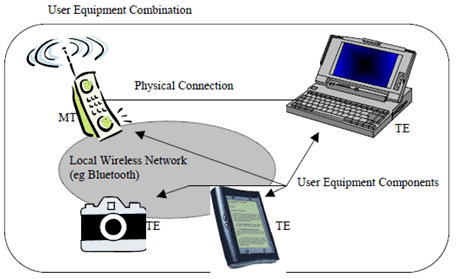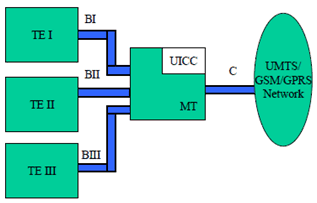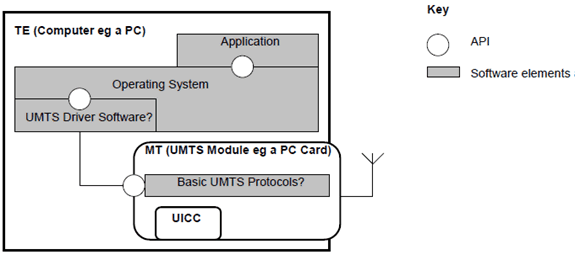Content for TR 22.944 Word version: 18.0.1
0 Introduction
1 Scope
2 References
3 Definitions, symbols and abbreviations
3.1 Definitions
3.2 Abbreviations
4 General Aspects
4.1 Overview of User Equipment
4.2 Background to Requirements
4.3 Assumptions
...
...
0 Introduction p. 4
The future environment will be characterised by features such as multimedia services and the convergence of 3GPP systems and the Internet. In this environment the total User Equipment used to access 3GPP services may be implemented over a number of physical devices. For example the User Equipment may include a PC or PDA with appropriate client software as well as a separate module containing radio protocols and other elements. These cases are referred to under the term "UE Functionality Split" or just "UE Split".
This report identifies scenarios and requirements for UE Functionality Split.
1 Scope p. 5
This report identifies scenarios and requirements for UEs with functionality split over multiple devices. Scenarios that are required to be supported in the standard are defined in detail. The requirements in this report should enable interoperability between user equipment components from different vendors. This report is not intended to identify all possible or permitted functionality splits. Certain splits of functionality may be prohibited for security or other reasons. This report does not identify all prohibited scenarios.
2 References p. 5
The following documents contain provisions which, through reference in this text, constitute provisions of the present document.
- References are either specific (identified by date of publication, edition number, version number, etc.) or non specific.
- For a specific reference, subsequent revisions do not apply.
- For a non-specific reference, the latest version applies. In the case of a reference to a 3GPP document (including a GSM document), a non-specific reference implicitly refers to the latest version of that document in the same Release as the present document.
[1]
TS 21.905: "Vocabulary for 3GPP Specifications".
[2]
TS 22.060: "General Packet Radio Service (GPRS); Service Description; Stage 1".
[3]
TS 22.228: "Service Requirements for the IP Multimedia; Core Network Subsystem; Stage 1".
[4]
TS 23.101: "General UMTS Architecture".
[5]
TS 24.002: "GSM-UMTS Public Land Mobile Network (PLMN) access reference configuration".
3 Definitions, symbols and abbreviations p. 5
3.1 Definitions p. 5
User Equipment Combination:
All the user equipment that is connected and used together in a particular scenario. For example a user equipment combination may consist of an MT and all the TEs that are connected to that MT.
User Equipment Component:
Any one of a number of separate components of user equipment. User equipment components include MTs and TEs.
3.2 Abbreviations p. 5
For the purposes of the present document, the following abbreviations apply:
CC
Call Control
CCC
Call Control Client
CS
Circuit Switched
DT
Data Termination
IMEI
International Mobile Station Equipment Identities
IMS
IP Multimedia Core Network Subsystem
IMSI
International Mobile Subscriber Identifier
IPAF
IP Adaptation Function
IMC
IMS Media Coding
IPDT
IP Data Termination
ISIM
IMS SIM
LAN
Local Area Network
MAC
Medium Access Control
MM
Mobility Management
MT
Mobile Terminal
PC
Personal Computer
PCM
Pulse Code Modulation
PDP
Packet Data Protocol
PDA
Personal Digital Assistant
PS
Packet Switched
RAN
Radio Access Network
RR
Radio Resource
SC
SIP client
SIM
Subscriber Identity Module
SM
Session Management
SMC
Session Management Client
TAF
Terminal Adaptation Function
TE
Terminal Equipment
TMSI
Temporary Mobile Subscriber Identifier
UE
User Equipment
UICC
UMTS Integrated Circuit Card
USIM
UMTS SIM
4 General Aspects p. 6
4.1 Overview of User Equipment p. 6
3GPP user equipment may take many forms. One case is that all the user equipment is integrated in to a single physical device. This report deals with cases where several different components make up the whole user equipment combination. An example is illustrated below. This illustration is only meant to introduce concepts and not imply any limitations or physical form for user equipment.

The user equipment combination contains at least one MT and may also contain one or more TEs.
4.2 Background to Requirements p. 7
The support of UE-functionality split in 3GPP should aim to exploit technology trends and to promote the convergence of 3GPP technologies with Internet and computing technologies. The objective of this report is to identify a scenario which is seen as being particularly important for the success of the 3GPP system. The scenario should:
- correspond to likely physical scenario for available equipment
- offer attractive commercial opportunities
- be simple enough to allow requirements capture and technical specifications to be completed
- align with other standards (e.g. Bluetooth, PC-Card) and common industry practice (e.g. major operating systems) where appropriate
- Ability for applications to evolve without changing hardware or firmware. This will improve service velocity.
- Ability of 3GPP applications to integrate with a user's other business, entertainment and communications tools.
- Allowing 3GPP applications to take advantage of the physical characteristics of computer (e.g. large display, memory, processing power)
- Ability to use hardware built into the TE (eg speaker, microphone) for input and output.
- Integration of emerging wireless LAN technologies (e.g. Bluetooth, 802.11b) with 3GPP networks

Figure 2: Multiple applications and/or users with one subscriber identity.
(⇒ copy of original 3GPP image)
(⇒ copy of original 3GPP image)
In this case the restriction is that only a single subscription on the UICC may be active. In this release a subscription consists of a SIM/USIM for non-IMS subscribers or a ISIM/USIM pair for IMS subscribers.
Examples of where scenario 1 is useful include:
- A PC or PDA contains a 3GPP defined radio module to allow it to access 3GPP services. The module may be a (semi)permanent part of the PC or PDA (similar to an embedded modem) or a removable module such as a PC card.
4.3 Assumptions p. 8
The following assumptions are made:
- The transport link between the TE and MT functions of the UE is not necessarily secure.
- A SIM/USIM application resident on a UICC is required to access the 3GPP system . Only a single USIM on a UICC can be active at any time (multiple USIMs can be located on a UICC).
- Charging is linked to one particular USIM.
- The secret key and the authentication algorithm cannot be transferred out from the USIM.
- The UICC must be present during the entire duration of the call. Periodic UICC presence detection is mandatory during a call.
- Requirements identified in [3] regarding the ISIM must be fulfilled.
